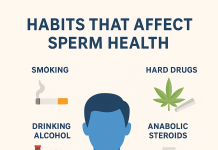Otitis Media refers to infection of the middle ear. The middle ear is the part of your ear just behind the eardrum, which contains the delicate bones that help transmit sound from your eardrum to your inner ear, thus making you able to hear.
Otitis Media occurs in individuals in all age groups, but is particularly common in children. In fact, most children would have at one least middle ear Infection before the age of six. However, as children grow older, they tend to have fewer infections.

What causes Otitis Media?
Middle ear infections are mostly caused by bacteria and viruses. A tube, known as the Eustachian tube connects the throat to the middle ear. The tube helps balance air pressure in the ear and prevents accumulation of fluids in the middle ear space. When you have a cold (throat infection), the infection can spread to your middle ear through the Eustachian tube, causing accumulation of fluids in the middle ear space and exerting pressure on your eardrum. Children have shorter eustachian tubes that easily transmit infections. This explains why otitis media is more common in them.
What are the symptoms?
Oftentimes, Otitis media begins with a cold. You may develop a sore throat and a runny nose. Thereafter, you may experience:
- Ear pain
- Fever
- Difficulty hearing
- Headache
- Feeling of fullness or pressure in your ear
- Difficulty sleeping
- Loss of appetite
- Yellow, brown or white discharge from the ear — in cases where the eardrum has torn

Babies and small children cannot clearly communicate their feelings. So they may show the following symptoms:
- Crying unconsolably
- Fever
- Pulling or rubbing the ears
- Not eating properly
- Vomiting
How is Otitis Media diagnosed?
To diagnose otitis media, your doctor would ask about your symptoms and examine your ear with an otoscope (a small instrument with a light source and magnifying lens used to view the ear) to check for features of an ear infection. If you have been having repeated ear infections, you may be referred to an ENT specialist (a doctor who treats diseases of the ear, nose and throat) for proper evaluation to be sure there is no serious underlying condition that is causing the repeated infections.
How is Otitis Media treated?
Usually, otitis media resolves on its own. You may however need some over-the-counter medications such as paracetamol and ibuprofen for pain relief. Consult your pharmacist to ensure you are using the right pain medicines and in their right dosage. Your doctor may also recommend certain eardrops to relieve the pain.
More importantly, remember that antibiotics are generally not recommended for the treatment of otitis media, except you are very sick and are showing signs of complications. So when in doubt, avoid self-medication and speak to your doctor.
How can you prevent ear infections?
Ear infections often follows a cold — and preventing a cold is not always easy. But a good hygiene can reduce your chances of catching one. Other measures you can put in place to avoid ear infections include:
- Avoid exposure to secondhand smoke. Do not allow others smoke around you or your child.
- Proper breastfeeding: adequate breastfeeding provides antibodies that helps children fight off bacteria and viruses that cause ear infections.
- Hold your baby upright when feeding them so that their head is above their stomach. This position prevents food from flowing backwards into their eustachian tubes.
- Ensure you and your children are fully vaccinated.
A Word from HealthFacts to You
Ear Infections are common, especially in children, and are mostly preceded by a cold. If you experience any of the symptoms listed in this post or you observe them in your child, see a doctor as soon as possible. Avoid using antibiotics without being instructed by your doctor. This is because, often times, the infections resolve on their own and antibiotics make very little difference.









